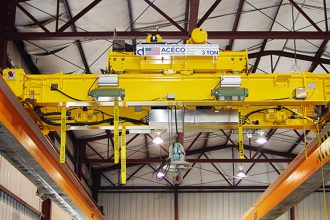Hoist Inspections: A Critical Aspect Of Overhead Handling Safety

To ensure both the safety and the optimal functionality of hoists, it is critical to inspect a variety of components and operating functions at specific intervals. The Hoist Manufacturers Institute (HMI) has developed the following content solely as a means to supplement/summarize hoist inspections. It is important to note that the manufacturer’s provided manual and respective ASME B30 volume shall always govern the inspection process and criteria for any given hoist.
There are two separate documents published by HMI that address hoist inspections:
- HMI 100.24: Inspection and Maintenance Manual – Hoist, which provides information and suggestions for the inspection of overhead hoists. The publication also advises that owners follow the safety recommendations included in ASME B30.16 – Safety Standard for Overhead Hoists (Underhung).
- HMI 100.74: Inspection and Maintenance Manual – Lever Hoist, which offers information and suggestions for the inspection of manually-operated lever hoists. The publication also advises that owners follow the safety recommendations included in ASME B30.21 – Safety Standard for Lever Hoists.
Additionally, both HMI 100.24 and HMI 100.74 advise that owners utilizing either type of hoist as part of an overhead crane or monorail system should include the safety and inspection requirements included in:
- ASME B30.2 Safety Standard for Overhead and Gantry Cranes (Top Running Bridge, Single or Multiple Girder, Top Running Trolley Hoist), and
- ASME B30.17 Safety Standard for Cranes and Monorails (With Underhung Trolley or Bridge).
Initial Inspection: An initial inspection confirms that the hoist is in working order prior to commissioning to ensure that all safety and operational functions perform as intended and in accordance with the application. Conducted by the original equipment manufacturer (OEM) or the authorized service technician who performed the modifications or repair work, these inspections include a load test, as well as verification of proper functioning. Documentation of inspection and load test certificate is provided to the hoist’s owner to keep on file for the life of the equipment. In instances where the hoist was repaired, modified, or altered, an initial inspection report documenting the affected components should also be kept on file.
Pre-Shift Inspection: Sometimes called a daily inspection, pre-operational (or “pre-op”) inspection, or a pre-start check, these visual and audible evaluations are conducted at the start of each shift by the hoist user. These inspections include a variety of items, including confirming that the hoist has not been tagged with an out-of-order sign; that all motions align with control device markings; that the hook and latch are not damaged or deformed and work properly; that the wire rope is not broken, kinked, or improperly wound; that the load chain is not worn, stretched, twisted or distorted; that travel limits and hoist limit switches function properly; and that there are no unusual sounds detected. Pre-shift inspections may or may not be documented on paper or electronically, although more operations are requiring their hoist operators to document that the assessment has been performed.
Frequent Inspection: The scheduling of frequent hoist inspections depends on multiple factors, including how often the hoist is used, the operating conditions, the loads lifted, and nature of the critical components. ASME B30.16 and ASME B30.21 define three different service classes: normal (with inspections required monthly), heavy (with inspections required weekly), and severe (with inspections required daily to weekly).
These inspections can be performed by a trained in-house employee or by an outside expert (either the OEM or a third-party inspection firm). All the same elements are examined as in a pre-shift inspection, but in more detail. Specifically, the inspection of the hook, wire rope, and load chain must be documented with a certification record that includes the date, signature of the inspector, and serial number (or identifier) of each component. Records should be maintained for the life of the hoist, as well as for identification of developing issues or ongoing wear trends. Any safety hazards should immediately be reported to the hoist owner.
Periodic Inspection: Highly detailed and exceedingly thorough, these inspections occur annually, semi-annually, or quarterly depending on the hoist’s service class, as well as the manufacturer’s recommendations. These evaluations are typically performed by an OEM or third-party inspection firm. They include all the items assessed in pre-shift and frequent inspections, as well as a comprehensive examination of the mechanical components, including detailed measurements to determine chain or wire rope deformation.
Reviewed are all functional operating mechanisms, including (as applicable, depending on the type of hoist) brakes, hook and latch, load chain, hand chain, reeving, lubricant levels, fastening devices, sprockets, suspension and frame, load block, chain attachments, gears, bearings, rollers, supporting structure and trolley, hook retaining devices and more. Further, inspection for wear, cracks, distortion, or other damage is performed on brakes, shafts, axles, couplings, sheaves and drums, trolley wheels and the trolley’s supporting structure.
Reports are kept on file both by the hoist owner and the company that performed the inspection. These reports document all findings and identify safety hazards, maintenance issues, and code or standard violations, as well as make recommendations for corrective actions. Because the hoist is disassembled for this inspection, after it has been reassembled both operational and load tests should be performed before it is returned to service.
In addition to identifying areas in need of service, the previous documentation collected from each of these four types of assessments is typically referred to by the inspector to pinpoint areas for additional review and determine trends in wear or usage. This information can be used to better develop a strategic maintenance and service plan to help prolong the life of the hoist and improve total cost of ownership.
Want to learn more about the HMI hoist specifications? They are available, here.



